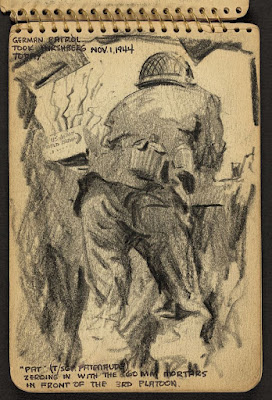Victor Lundy (1923-) kept a sketchbook of his experiences in World War II.
His early sketches show the journey to the war zone. On his way to being deployed in Europe, the 21 year old artist wrote: "And you know, we were far from even thinking of combat. They didn’t tell us. We didn’t know what was going to happen, once we landed. …—you know, the day it happens they tell you.”
 |
| Victor Lundy. En-route to Europe. Promenade Deck. (September 2, 1944) |
 |
| “Pat” (T/Sgt. Patenaude) zeroing in with the 60 mm mortars in front of the 3rd platoon. (November 1, 1944) |
Trained as an architect, he expected to serve in the rebuilding of Europe. But he was assigned to the infantry and went to the front lines, where he was wounded. Through it all, he documented air raids and crap games, and he sketched dead and wounded soldiers.
Lundy, now 92, has had a prolific career as an architect. He donated his sketchbooks to the Library of Congress, where they've been scanned and put online.
-----
Victor Lundy Archive at Library of Congress
More about Lundy at MyModernMet
Victor Lundy on Wikipedia
 |
| Victor Lundy, Rec. hall, intelligence school |
-----
Victor Lundy Archive at Library of Congress
More about Lundy at MyModernMet
Victor Lundy on Wikipedia
Thanks, Jason Waselenko

I followed the link and looked at all of these sketches. What a fantastic treasure, I am grateful he took the time to do these sketches, and to share them.
ReplyDeleteJim, how do you think Lundy achieved such thick pencil marks? I like how it blurs the line between drawing and painting. It reminds me very much of Theodore Kautzky's book "Pencil Broadsides" first published in 1940. I suppose Lundy might have been aware of Kautzky's artwork. Kautzky suggests a "kid-finish Bristol or some paper of similar surface and a good quality drawing pencil of 2B grade. For deeper blacks you may sometimes need a 4B but no others are really necessary. A sharp knife and a sandpaper block will complete your equipment. The sandpaper block is just as important as the pencil. Don't forget it. After the wood of the pencil has been whittled away to expose about a quarter of an inch of cylindrical lead, the lead is rubbed at an angle on the sandpaper to produce a flat wedge point. The broad strokes are to be made with the flat side of this wedge held evenly against the paper."
ReplyDeleteJim, we thought of Kautzky, too, as a possible influence. HE may have used a 2B or 3B or a carpenter's pencil, or an Ebony pencil. That way of drawing was very popular in his time, and you can see it in Ernest Watson, Arthur Guptill, and James Perry Wilson, all of whom Mr. Lundy would have been aware of. If Mr. Lundy is reading this, perhaps he might comment on this question.
ReplyDeleteThere was a lovely exhibition at the Rockland County Historical Society many years back called Ghost Army which featured the story that the US Army used inflatable tanks, planes and other gear to make the Germans believe we had more machinery on the ground than we really did.
ReplyDeleteThe truly remarkable feature of this exhibition though was the large amount of artwork on display created by soldiers during their deployment. These were beautiful pencil sketches, watercolors and paintings of villages, portraits of soldiers etc. The exhibit was made into a book, which is available at Amazon:
https://www.amazon.com/dp/1616893184/ref=cm_sw_em_r_mt_dp_U_QMxZDbZ1602YA
As an aside, my father painted a dozen watercolors while stationed in Buson (then Puson) Korea in the early 1950s during the Korean War. We still have 3-4 but most were given away as gifts to friends. We certainly treasure these watercolors as they show what daily life was like in the Korean countryside with villagers doing their laundry in the local streams, images of his camp etc.
Thanks James and Jason for jogging my memory. I have seen his sketchbook before. This time I'll add the link to my bookmarks so I'll be reminded to look again more often.
ReplyDeleteWhen in Charleston SC this past Winter to see an Ogden Pleissner exhibit I bought a book from the museum store titled "Civil War Sketch Book" by Katz and Virga. It's a amazing compilation of hundreds of sketches by war correspondents and some soldiers. Another that I happened across in a bookstore is "Men Without Guns" Edited by MacKenzie. It's the story of WWII corpsman/doctors/nurses told mostly by artwork.
What great comments, thanks All. I love the way he rendered the left stairway in the Intelligence School sketch, showing the light and shade.
ReplyDeleteVery cool. Did the USA have a program similar to Canada's war artists program which commissioned works from artists in active service during WWII? Lawren Harris's Tank Advance is one of the more famous pieces to have come out of that program though Coleville's Tragic Landscape is perhaps the most evocative.
ReplyDeleteWow, I'll have to take the time to look through all of these, must be an incredibly interesting firsthand look into the war. Is there a convenient way to download everything? The current viewing format seems a bit inconvenient and time consuming.
ReplyDeleteThank you James. I have enjoyed learning more about his style from the comments.
ReplyDeletePriceless
ReplyDelete